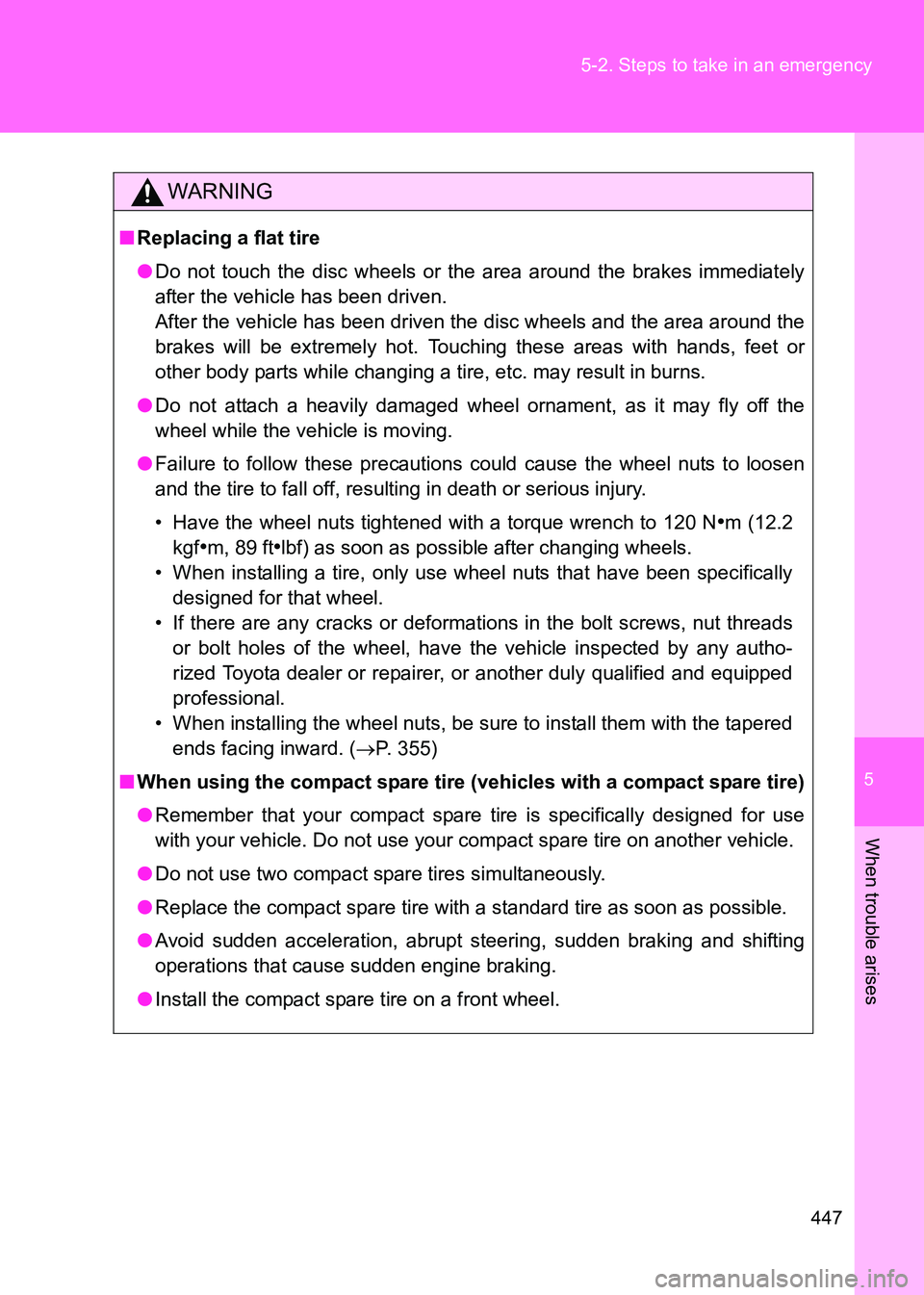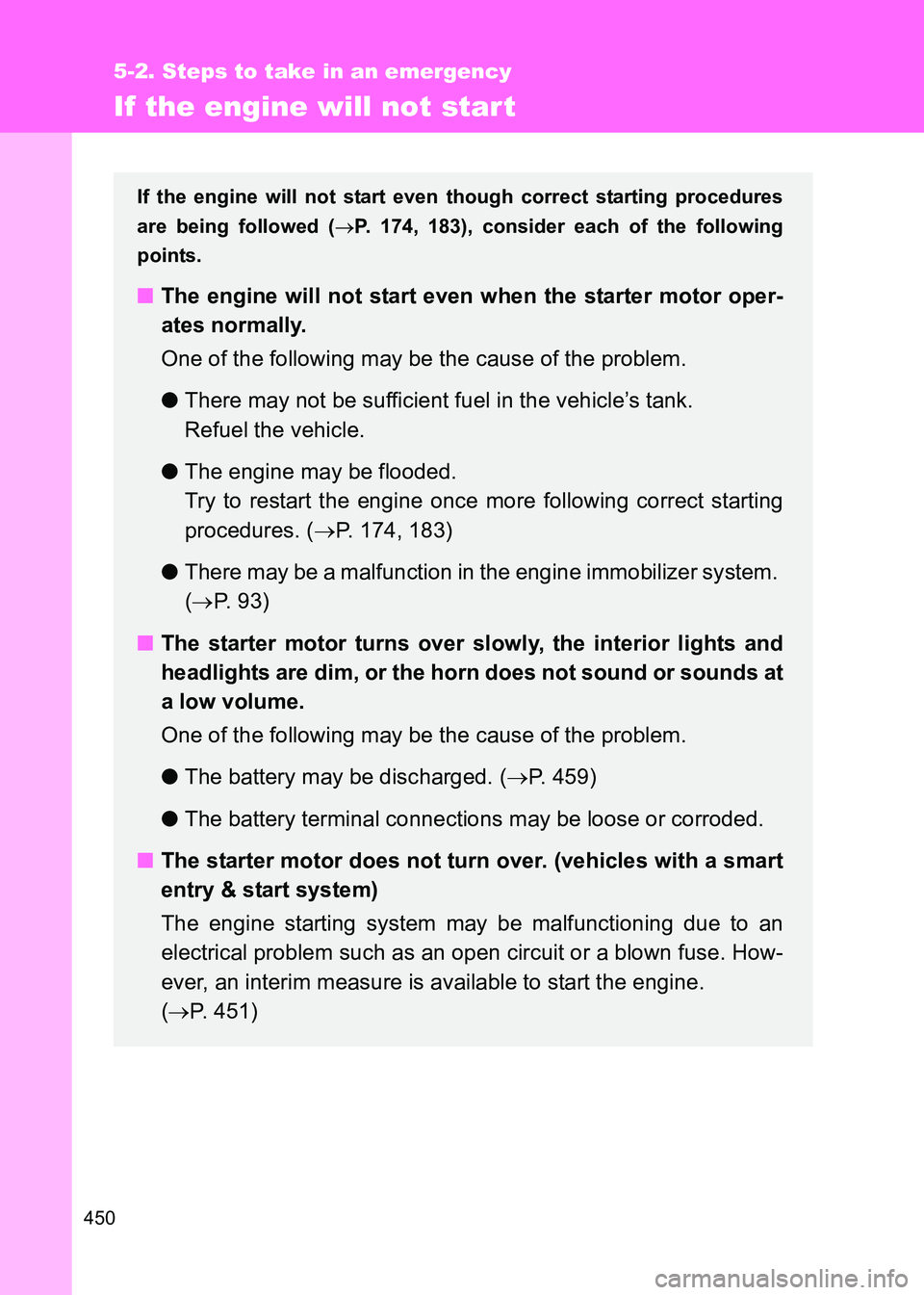Page 421 of 505
5
421
5-2. Steps to take in an emergency
When trouble arises
86_EE (OM18071E)
Once
(Flashes)
(Flashes quickly in green)
Indicates that the
steering lock has
not been
released. Release
the steer-
ing lock.
(
→ P. 180)
Con-
tinu-
ous
(Flashes)
(Vehicles with an auto- matic transmission) The “ENGINE
START STOP”
switch has been
turned off with the
shift lever in a
position other
than P.
Shift the
shift lever
to P.
Once
(Flashes)
(Vehicles with an auto- matic transmission) After the
“ENGINE START
STOP” switch
has been turned
off with the shift
lever in a posi-
tion other than P,
the shift lever has
been shifted to P.
Turn the
“ENGINE
START
STOP”
switch off.
■ Warning buzzer
In some cases, the buzzer may not be heard because of noisy place or an
audio sound.
Interior
buzzerExterior
buzzerWarning messageDetailsCorrection procedure
Page 423 of 505
5
423
5-2. Steps to take in an emergency
When trouble arises
86_EE (OM18071E)
■
Before repairing the tire
●Stop the vehicle in a safe place on a hard, flat surface.
● Set the parking brake.
● Shift the shift lever to P (vehicles with an automatic transmis-
sion) or N (vehicles with a manual transmission).
● Stop the engine.
● Turn on the emergency flashers. ( →P. 384)
● Check the degree of the tire
damage.
• Do not remove the nail or
screw from the tire.
Removing the object may
widen the opening and
prevent emergency repair
with the repair kit.
• To avoid sealant leakage,
move the vehicle until the
area of the puncture, if
known, is positioned at
the top of the tire.
Page 429 of 505
5
429
5-2. Steps to take in an emergency
When trouble arises
86_EE (OM18071E)
Connect the compressor power
plug to the power outlet.
Vehicles without a smart entry &
start system: The engine switch
must be in the “ACC” position.
Vehicles with a smart entry & start
system: The “ENGINE START
STOP” switch must be in ACCES-
SORY mode.
Connect the air compressor
hose by threading it on the valve.
Left-hand drive vehicles: Check
the specified inflation pressure.
The label is placed as shown in
the illustration.
Right-hand drive vehicles: Check
the specified inflation pressure.
The label is placed as shown in
the illustration.
Power
outlet
STEP12Power plug
STEP13
CompressorHose
STEP14
STEP14
Page 438 of 505
438
5-2. Steps to take in an emergency
86_EE (OM18071E)
If you have a flat tire (vehicles with a spare tire)
Your vehicle is equipped with a spare tire. The flat tire can be
replaced with the spare tire.
■Before jacking up the vehicle
●Stop the vehicle in a safe place on a hard, flat surface.
● Set the parking brake.
● Shift the shift lever to P (vehicles with an automatic transmis-
sion) or R (vehicles with a manual transmission).
● Stop the engine.
● Turn on the emergency flashers. ( →P. 384)
■ Location of the spare tire, jack and tools
Vehicles with a compact spare tire
Jack Jack handle
Spare tire
Towing eyelet
Screwdriver Wheel nut
wrench
Page 446 of 505

446
5-2. Steps to take in an emergency
86_EE (OM18071E)
WARNING
■
Using the tire jack
Improper use of the tire jack may lead to death or serious injuries due to the
vehicle suddenly falling off the jack.
●Do not use the tire jack for any purpose other than replacing tires or install-
ing and removing tire chains.
● Only use the tire jack that comes with this vehicle for replacing a flat tire.
Do not use it on other vehicles, and do not use other tire jacks for replac-
ing tires on this vehicle.
● Always check that the tire jack is securely set to the jack point.
● Do not put any part of your body under the vehicle supported by a jack.
● Do not start or run the engine while your vehicle is supported by the jack.
● Do not raise the vehicle while someone is in it.
● When raising the vehicle, do not put an object on or under the jack.
● Do not raise the vehicle to a height greater than that required to replace
the tire.
● Use a jack stand if it is necessary to get under the vehicle.
Take particular care when lowering the vehicle to ensure that no one working
on or near the vehicle may be injured.
Page 447 of 505

5
447
5-2. Steps to take in an emergency
When trouble arises
86_EE (OM18071E)
WARNING
■
Replacing a flat tire
●Do not touch the disc wheels or the area around the brakes immediately
after the vehicle has been driven.
After the vehicle has been driven the disc wheels and the area around the
brakes will be extremely hot. Touching these areas with hands, feet or
other body parts while changing a tire, etc. may result in burns.
● Do not attach a heavily damaged wheel ornament, as it may fly off the
wheel while the vehicle is moving.
● Failure to follow these precautions could cause the wheel nuts to loosen
and the tire to fall off, resulting in death or serious injury.
• Have the wheel nuts tightened with a torque wrench to 120 N
•m (12.2
kgf
•m, 89 ft•lbf) as soon as possible after changing wheels.
• When installing a tire, only use wheel nuts that have been specifically designed for that wheel.
• If there are any cracks or deformations in the bolt screws, nut threads or bolt holes of the wheel, have the vehicle inspected by any autho-
rized Toyota dealer or repairer, or another duly qualified and equipped
professional.
• When installing the wheel nuts, be sure to install them with the tapered ends facing inward. ( →P. 355)
■ When using the compact spare tire (vehicles with a compact spare tire)
●Remember that your compact spare tire is specifically designed for use
with your vehicle. Do not use your compact spare tire on another vehicle.
● Do not use two compact spare tires simultaneously.
● Replace the compact spare tire with a standard tire as soon as possible.
● Avoid sudden acceleration, abrupt steering, sudden braking and shifting
operations that cause sudden engine braking.
● Install the compact spare tire on a front wheel.
Page 450 of 505

450
5-2. Steps to take in an emergency
86_EE (OM18071E)
If the engine will not start
If the engine will not start even though correct starting procedures
are being followed ( →P. 174, 183), consider each of the following
points.
■ The engine will not start even when the starter motor oper-
ates normally.
One of the following may be the cause of the problem.
●There may not be sufficient fuel in the vehicle’s tank.
Refuel the vehicle.
● The engine may be flooded.
Try to restart the engine once more following correct starting
procedures. ( →P. 174, 183)
● There may be a malfunction in the engine immobilizer system.
(→ P. 93)
■ The starter motor turns over slowly, the interior lights and
headlights are dim, or the horn does not sound or sounds at
a low volume.
One of the following may be the cause of the problem.
●The battery may be discharged. ( →P. 459)
● The battery terminal connections may be loose or corroded.
■ The starter motor does not turn over. (vehicles with a smart
entry & start system)
The engine starting system may be malfunctioning due to an
electrical problem such as an open circuit or a blown fuse. How-
ever, an interim measure is available to start the engine.
(→ P. 451)
Page 451 of 505

5
451
5-2. Steps to take in an emergency
When trouble arises
86_EE (OM18071E)
Emergency start function (vehicles with a smart entry & start system)
When the engine does not start, the following steps can be used as
an interim measure to start the engine if the “ENGINE START STOP”
switch is functioning normally:
Vehicles with an automatic transmission
Set the parking brake.
Put the shift lever in P.
Set the “ENGINE START STOP” switch to ACCESSORY
mode.
Press and hold the “ENGINE START STOP” switch about 15
seconds while depressing the brake pedal firmly.
Even if the engine can be started using the above steps, the system
may be malfunctioning. Have the vehicle checked by any authorized
Toyota dealer or repairer, or another duly qualified and equipped pro-
fessional.
■ The starter motor does not turn over, the interior lights and
headlights do not turn on, or the horn does not sound.
One of the following may be the cause of the problem.
●One or both of the battery terminals may be disconnected.
● The battery may be discharged. ( →P. 459)
● There may be a malfunction in the steering lock system. (vehi-
cles with a smart entry & start system)
Contact any authorized Toyota dealer or repairer, or another duly
qualified and equipped professional if the problem cannot be
repaired, or if repair procedures are unknown.
STEP 1
STEP 2
STEP 3
STEP 4